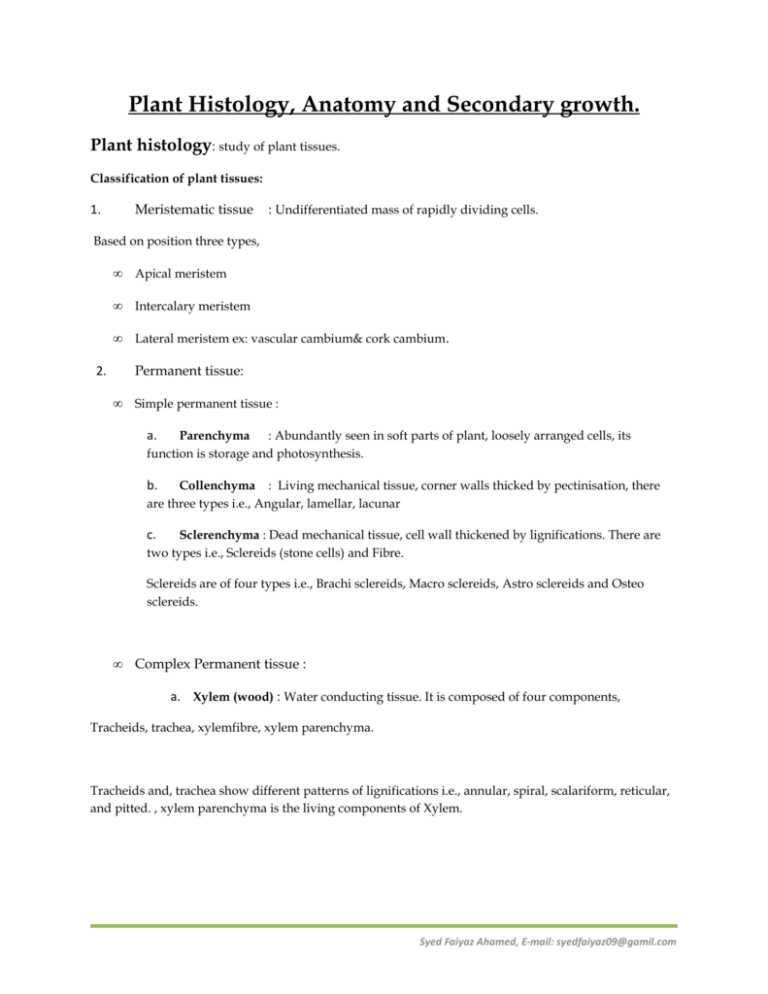Plant Histology, Anatomy and Secondary growth.
advertisement

Plant Histology, Anatomy and Secondary growth. Plant histology: study of plant tissues. Classification of plant tissues: Meristematic tissue 1. : Undifferentiated mass of rapidly dividing cells. Based on position three types, • Apical meristem • Intercalary meristem • Lateral meristem ex: vascular cambium& cork cambium. Permanent tissue: 2. • Simple permanent tissue : a. Parenchyma : Abundantly seen in soft parts of plant, loosely arranged cells, its function is storage and photosynthesis. b. Collenchyma : Living mechanical tissue, corner walls thicked by pectinisation, there are three types i.e., Angular, lamellar, lacunar c. Sclerenchyma : Dead mechanical tissue, cell wall thickened by lignifications. There are two types i.e., Sclereids (stone cells) and Fibre. Sclereids are of four types i.e., Brachi sclereids, Macro sclereids, Astro sclereids and Osteo sclereids. • Complex Permanent tissue : a. Xylem (wood) : Water conducting tissue. It is composed of four components, Tracheids, trachea, xylemfibre, xylem parenchyma. Tracheids and, trachea show different patterns of lignifications i.e., annular, spiral, scalariform, reticular, and pitted. , xylem parenchyma is the living components of Xylem. Syed Faiyaz Ahamed, E-mail: syedfaiyaz09@gamil.com b. Phloem (Bast): Food conducting tissue, It is composed of four components, Sieve elements, companion cell, phloem parenchyma, phloemfibre. Phloemfibre is the dead components of phloem. Vascular bundles : Compact mass of xylem and phloem with or without cambium. Types of Vascular Bundles: Conjoint collateral open, conjoint collateral closed and radial vascular bundles. Secondary growth : Increase in the girth or thickness of stem or root of Dicotplant. 1. Intrastelar Activity: Cambium in between the xylem and phloem is called intrafascicular Cambium; the parenchyma cells of medullary rays undergo dedifferentiation to become interfascicular cambium. Intrafascicular cambium and Interfascicular cambium join end to end to become cambiul ring. The cambiums produce secondary xylem tissue towards the pith and Secondary phloem towards outside. Stelar cambium is more active during spring and produce thick ring of sprig wood. This is called spring wood. Stelar cambium is less active during autumn and produce autumn wood. This is called autumn wood. Spring wood and autumn wood constitute annually. The secondary xylem in the center becomes hard and dark in color. This is called Heart wood or Duramen. The later formed secondary xylem is lighter in color and is called Sap wood or Alburnun. 2. Extrastelar Activity: Formation of cork cambium or Phellogen in cortex by process of dedifferentiation. The phallohen produce Cork or Phellem towards outside and Secondary Cortex or Phelloderm towards inside. The Cork, Cork cambium, and secondary cortex constitute bark. Syed Faiyaz Ahamed, E-mail: syedfaiyaz09@gamil.com Practice Questions Sample questions for one mark. Q. What is Histology? Q. Define a Vascular Bundle Q. What is closed Vascular Bundle? Q. what is an open Vascular bundle? Q. Name the simple living Mechanical tissue Q. Name the simple dead Mechanical tissue Q. What is Duramen? Q. what is Alburnun? Q. What is an Atactostele? Q. what is a Eustele? Sample questions for Two mark. Q. Differentiate collenchymas from Sclerenchyma. Q. Name the Xylem elements. Q. Name the elements of Phloem. Q. Differentiate between a tracheid and Trachea. Q. Differentiate between heart wood and Sap wood. Sample questions in practical part for five marks. Explain with the help of a neat labeled diagram, Q. Anatomy or T S of Dicot Stem: Ex. Helianthus (sunflower) Q. Anatomy or T S of monocot stem: Ex Zea mays. Q. Anatomy or T S of Dicot Root: Ex Helianthus (sunflower) Q. Anatomy or T S of Monocot Root: Q. Anatomy or T S of Dicot leaf: Ex Helianthus (sunflower) Q. Anatomy or T S of monocot leaf: Syed Faiyaz Ahamed, E-mail: syedfaiyaz09@gamil.com Syed Faiyaz Ahamed, E-mail: syedfaiyaz09@gamil.com











